



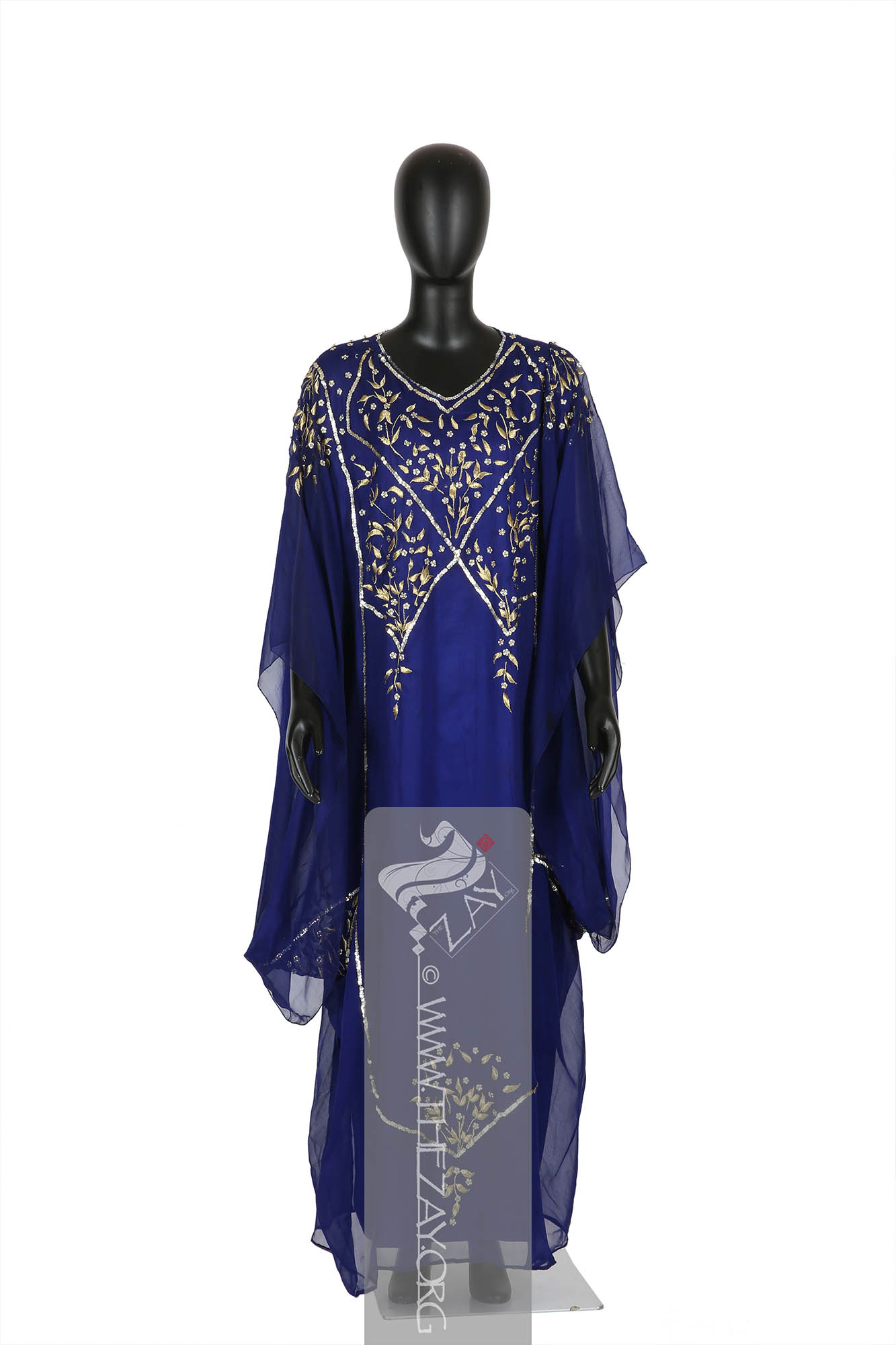

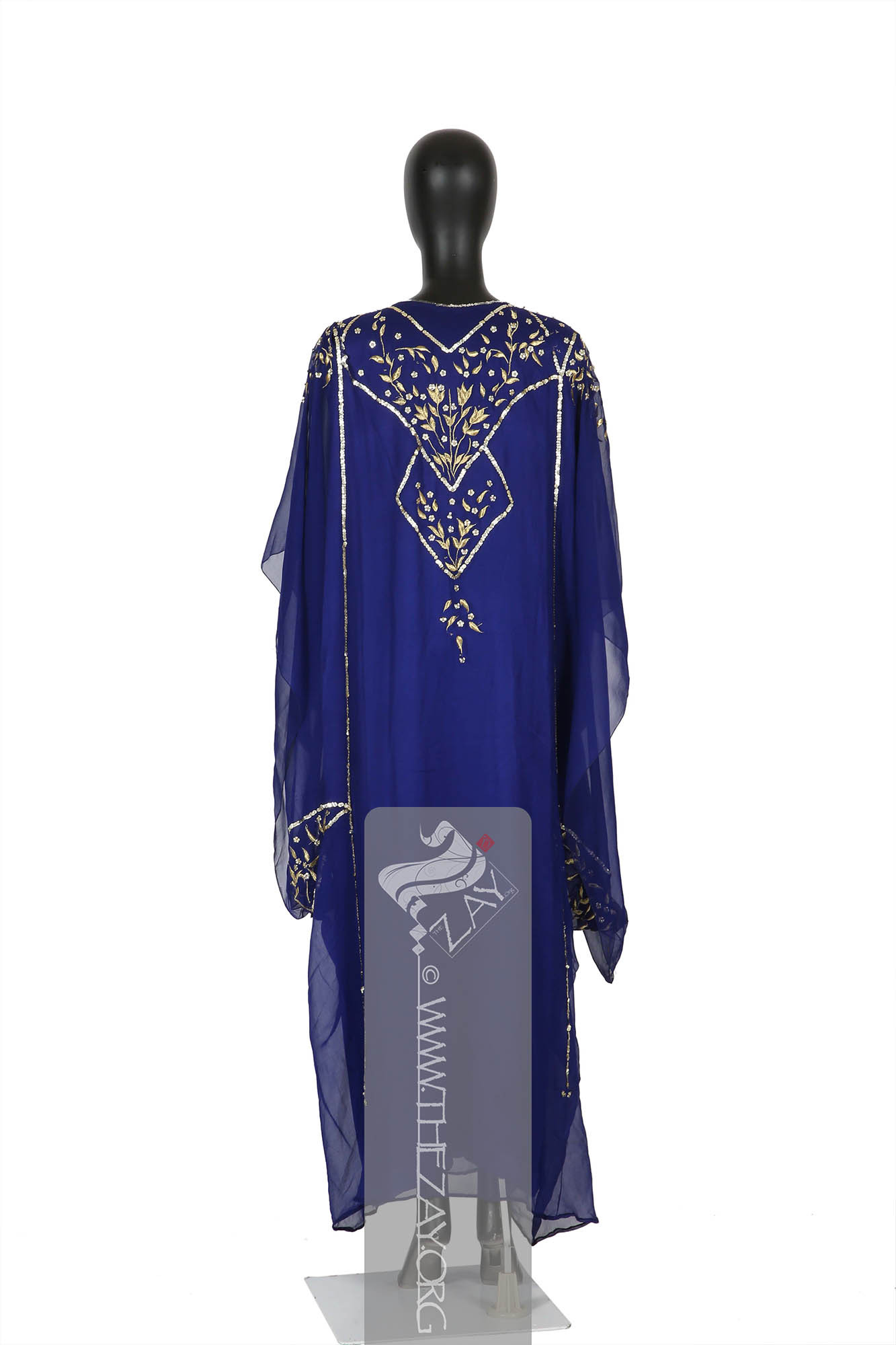
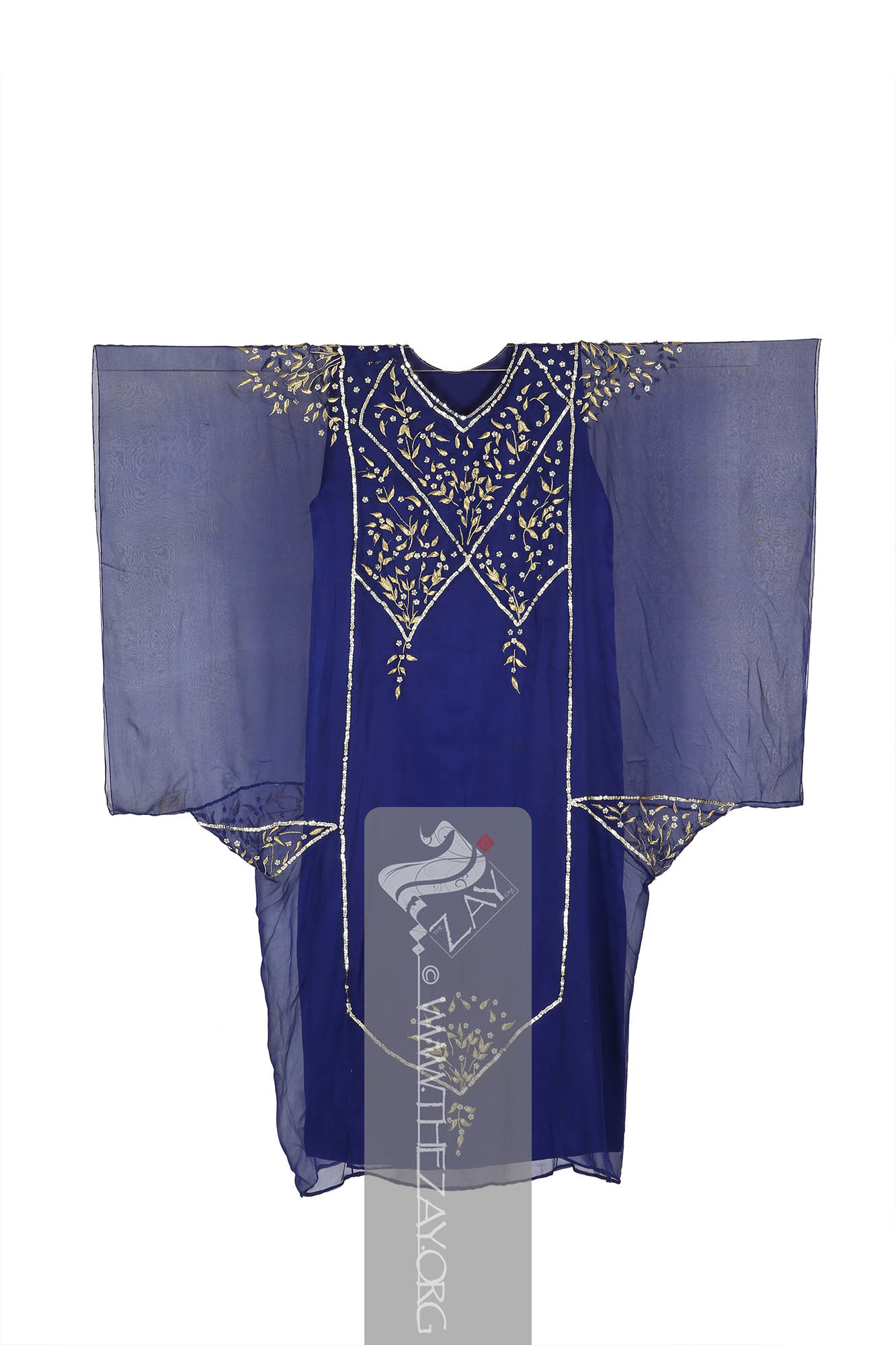

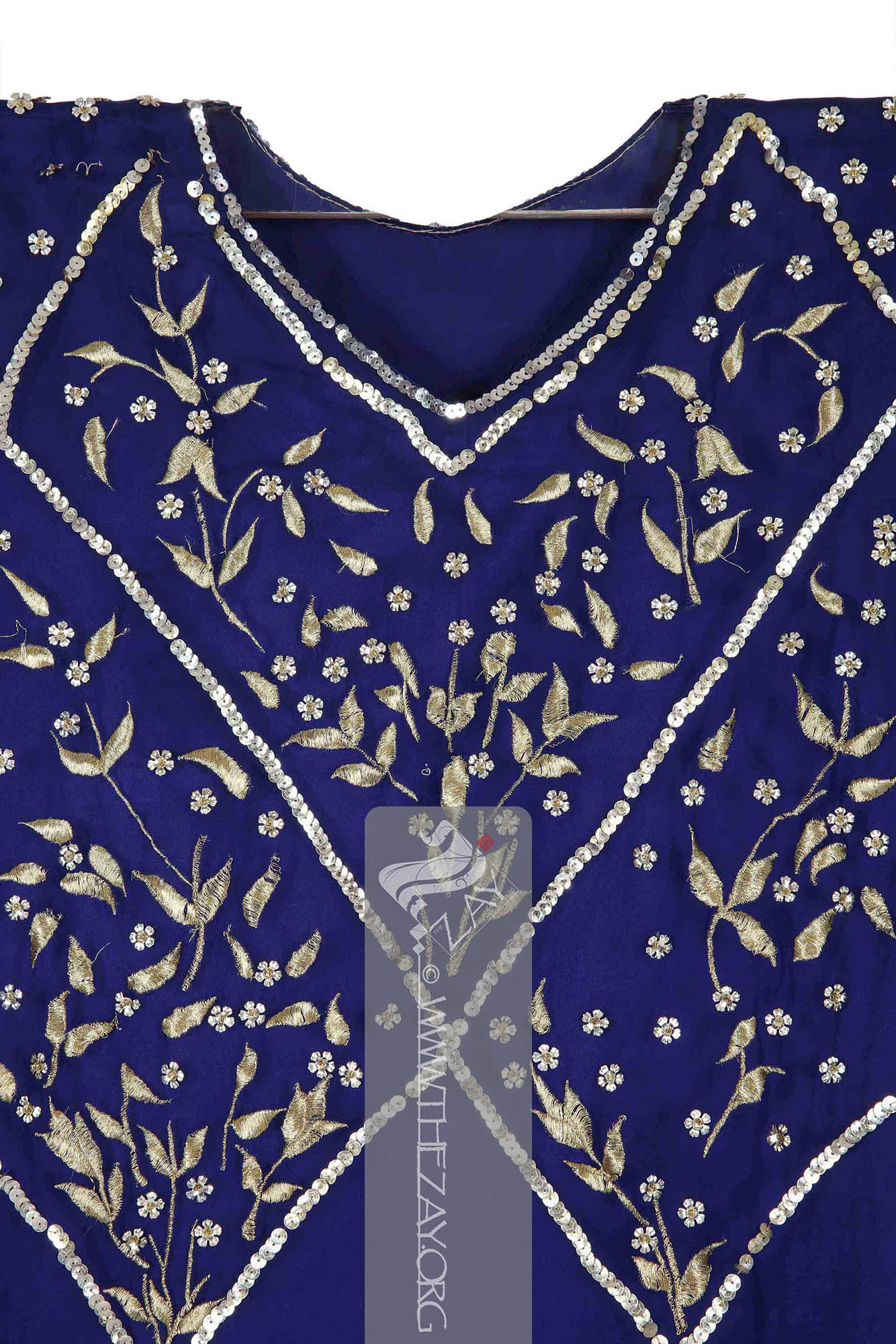
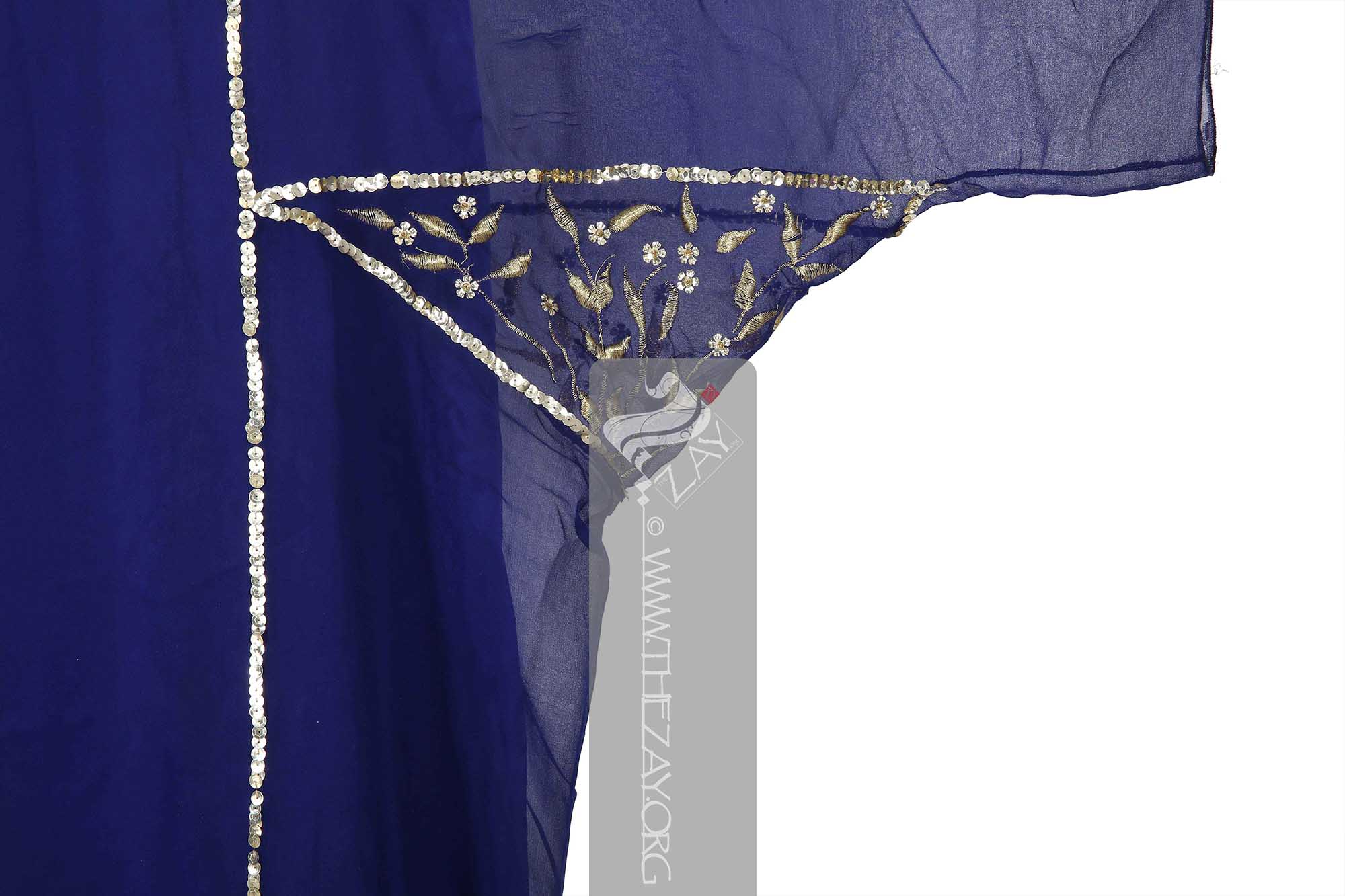
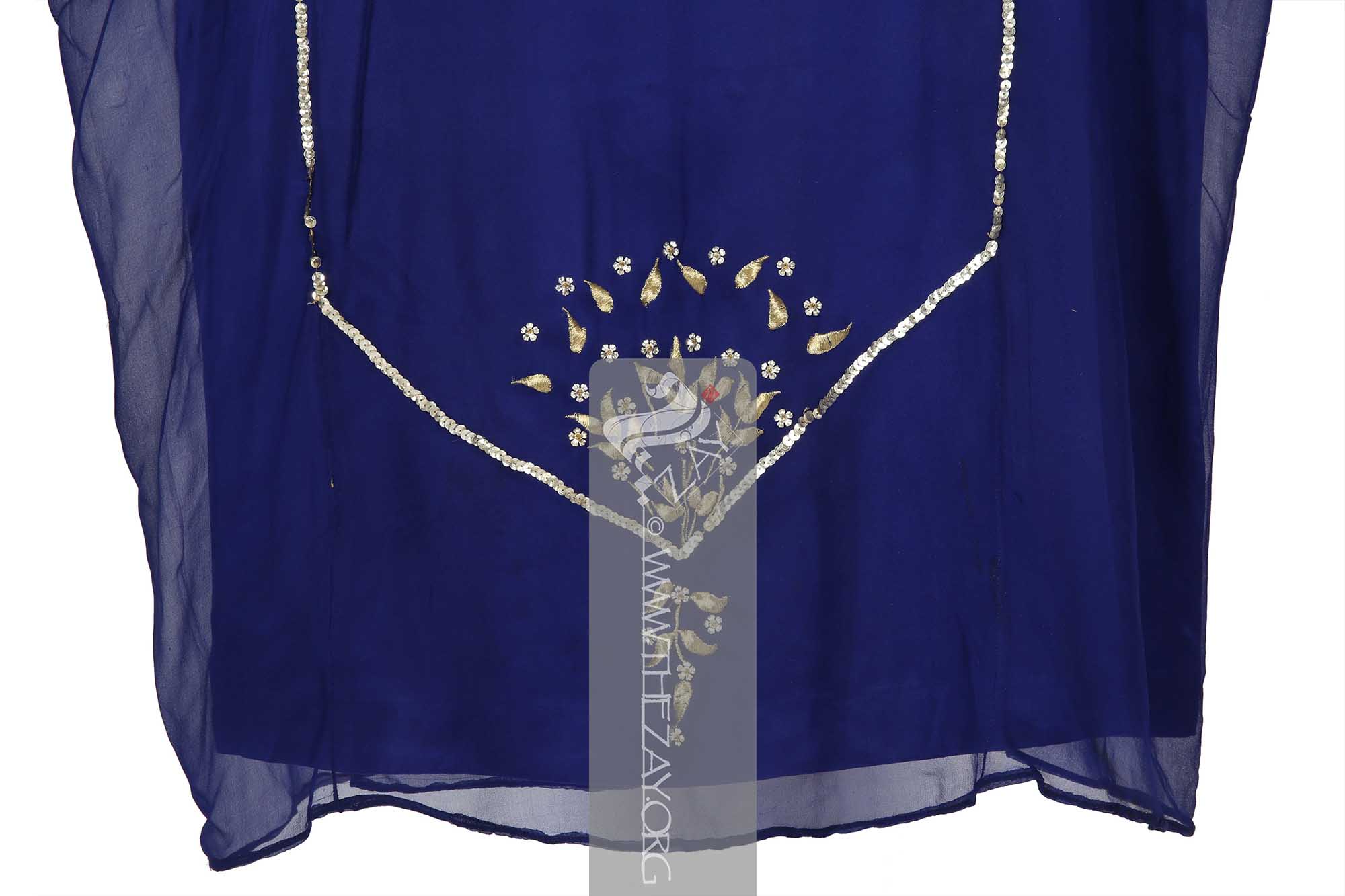
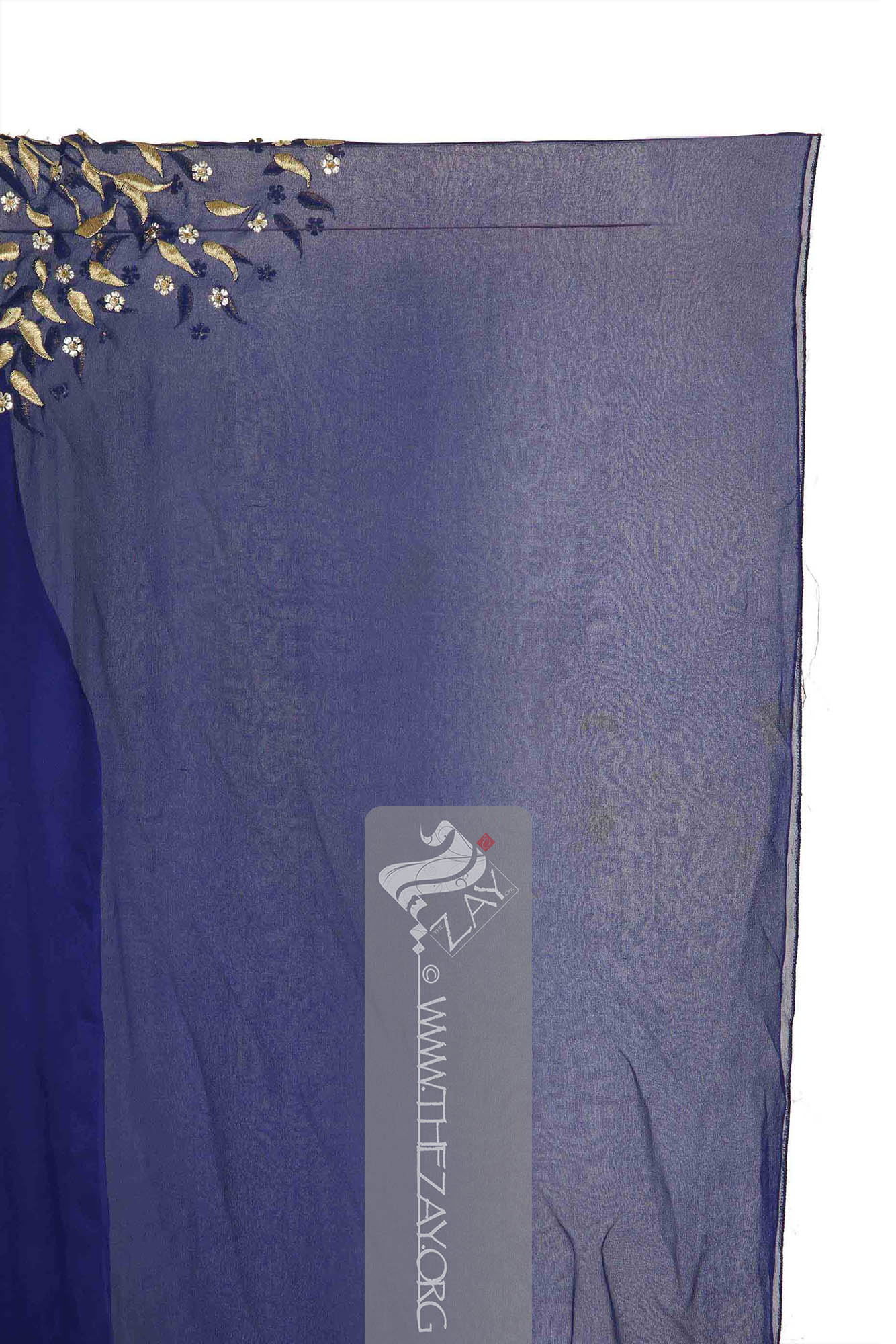
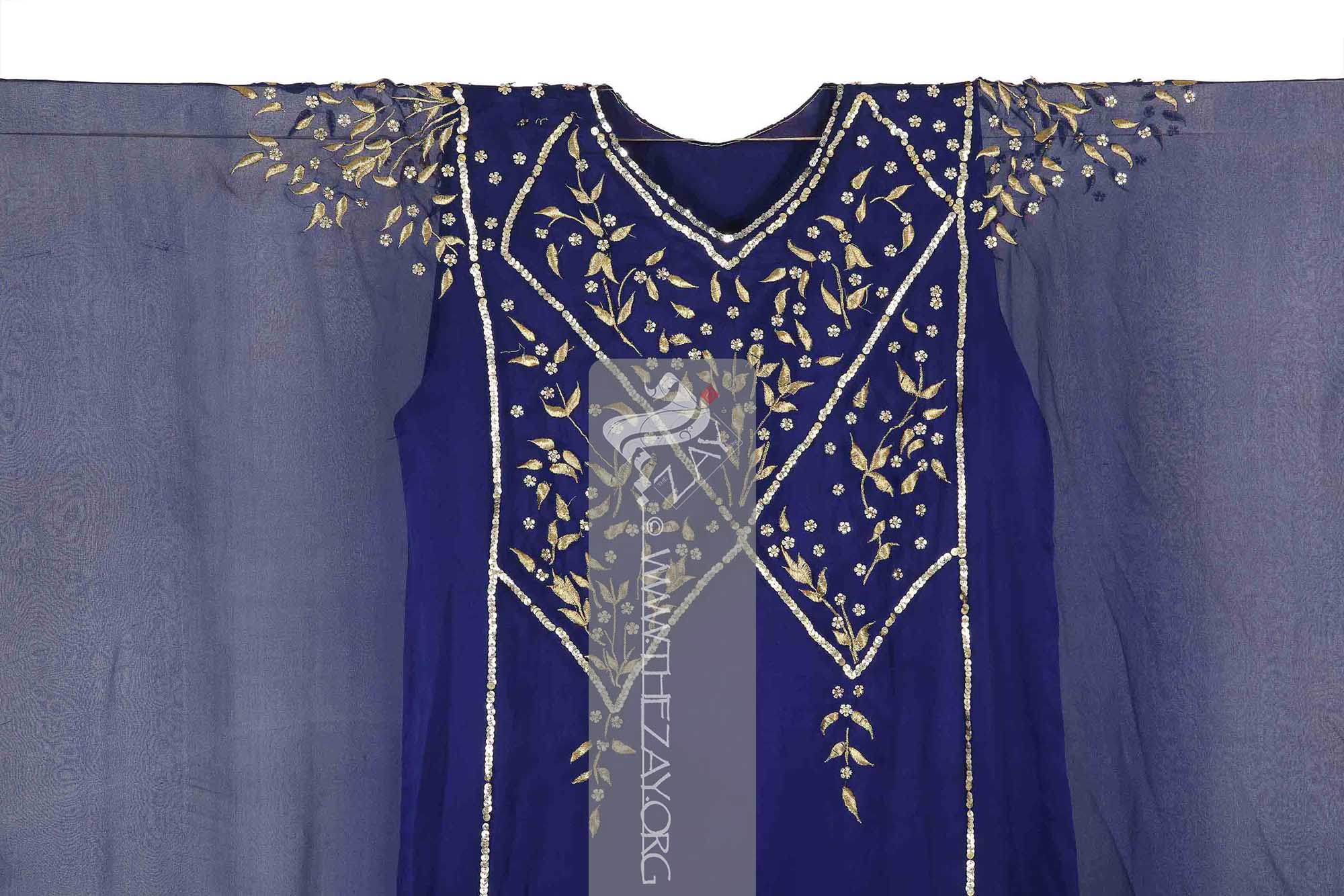
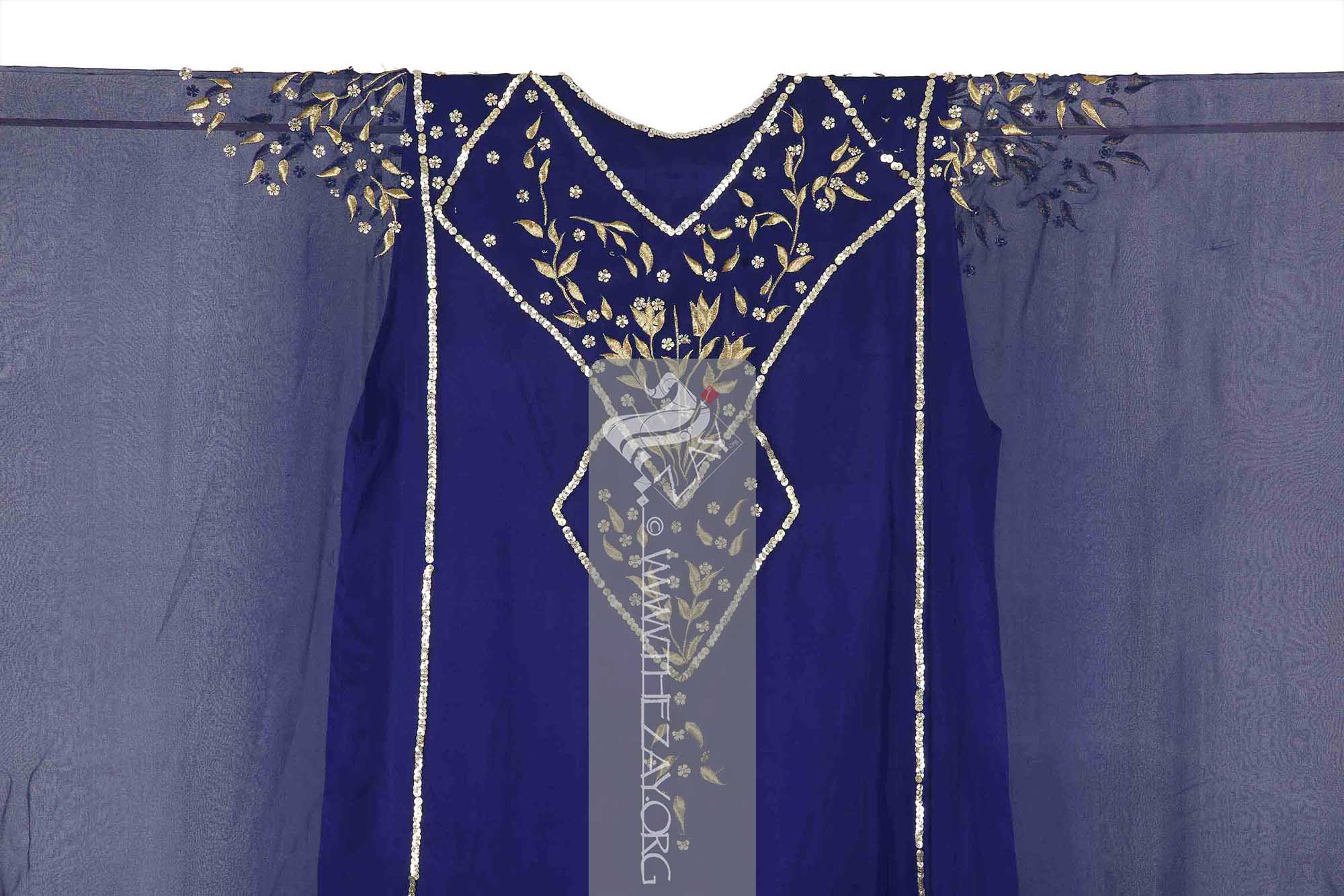
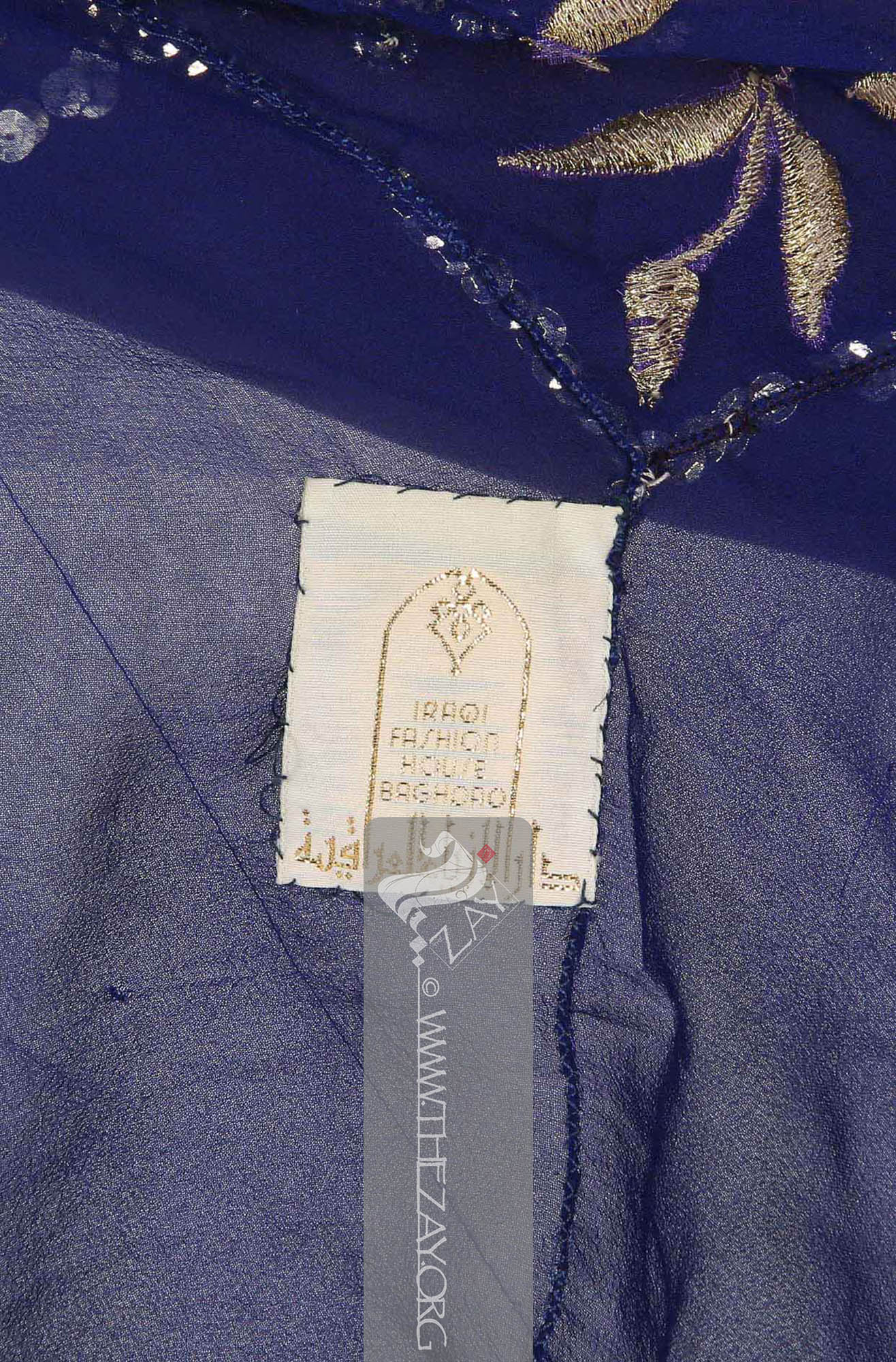
| Local Name | Hashmi, Thawb |
| Object Category | Overgarment |
| Gender | Female |
| Date of object | c. 20th century |
| Place Of orgin | Iraq |
| Region | Iraq |
| Object Range | - |
| Dimensions | Length: 140 cm Width: 122 cm |
| Materials | Silk Other |
| Technique | Machine Stitched Hand Embroidered |
| Color | |
| Motif | Floral |
| Provenance | Gifted, Firyal Killidar, Iraq 1996 |
| Location | The Zay Zay: (Arabic: costume, Pl. azyaā’), a set of clothes in a style typical of a particular country or historical period. Initiative |
| Status | In Storage |
| ZI number | ZI1996.500890.2 IRAQ |
Object Note
Part of a lot with two more items (ZI1996.500890.1 IRAQ, ZI1996.500890.3 IRAQ) also in the collection.
Object History
This piece was gifted to Dr. Reem Tariq
Ṭariq: (Arabic; Synonym: tulle_bi_talli; talli; badla; khus_dozi ), series of small metal knots made on a woven net ground as embellishment. The term is commonly used in the Levant Arab region specifically in Lebanon. Ṭariq: (Arabic; Synonym: tulle_bi_talli; talli; badla; khus_dozi ), series of small metal knots made on a woven net ground as embellishment. The term is commonly used in the Levant Arab region specifically in Lebanon.
Iraqi Fashion House (Dar al Aziya’ al Iraqiyah) was established by H.E. Friyal Al Kilidar in 1970 and remained under her directorship until 2005. It was the first and only one of its kind that aimed to display folkloric Iraqi costumes depicting the history of Iraq by reinterpreting the costumes of the people who inhabited the land and the nation states that were formed, dating from ancient Mesopotamia to the present. It also aimed to display the latest local and international fashion trends and showcase the collective Iraqi artists, calligraphers, poets, and designers.
Unfortunately, after the second Gulf War, it was plundered and looted to be rebuilt and reopened as the Iraqi House of Fashion in 2005, with new aspirations and directives. As for its founder and former director, Friyal Al Kilidar, she currently resides in the United States.
Object Features
This is a traditional Iraqi style woman’s tunic robe (thawb
Thawb: (Arabic: thawb, Pl. Athwāb/thībān), can be pronounced thobe
Thobe: (Arabic: thawb, Pl. Athwāb/thībān), can be pronounced thawb or tobe
Tobe: (Arabic: thawb, Pl. Athwāb/thībān), can be pronounced thawb or thobe based on locale. The standard Arabic word for ‘fabric’ or ‘garment’. It can refer to a qamīs-like tunic worn by men and women in the Arabian Peninsula, Iraq, the southern and south-western ports and islands of Iran, and some countries in East and West Africa. More specifically, it can refer to the square-shaped Bedouin overgarment worn by women. based on locale. The standard Arabic word for ‘fabric’ or ‘garment’. It can also refer to a qamīs-like tunic worn by men and women in the Arabian Peninsula, Iraq, the southern and south-western ports and islands of Iran, and some countries in East and West Africa. More specifically, it can refer to the square-shaped Bedouin overgarment worn by women. or tobe
Tobe: (Arabic: thawb, Pl. Athwāb/thībān), can be pronounced thawb or thobe based on locale. The standard Arabic word for ‘fabric’ or ‘garment’. It can refer to a qamīs-like tunic worn by men and women in the Arabian Peninsula, Iraq, the southern and south-western ports and islands of Iran, and some countries in East and West Africa. More specifically, it can refer to the square-shaped Bedouin overgarment worn by women. based on locale. The standard Arabic word for ‘fabric’ or ‘garment’. It can also refer to a qamīs-like tunic worn by men and women in the Arabian Peninsula, Iraq, the southern and south-western ports and islands of Iran, and some countries in East and West Africa. More specifically, it can refer to the square-shaped Bedouin overgarment worn by women in the Arabian Gulf region. ), often locally referred to as the (hashmi
Hashmī: (Arabic: Hashim (House of) – an Arab royal family from the Banu Hashim clan of the Quraysh tribe), a type of elaborately decorated women’s traditional garment or thawb from Iraq that was named after the royal family that ruled Iraq until the mid 20th century.
The hashmi
Hashmī: (Arabic: Hashim (House of) – an Arab royal family from the Banu Hashim clan of the Quraysh tribe), a type of elaborately decorated women’s traditional garment or thawb from Iraq that was named after the royal family that ruled Iraq until the mid 20th century. Kalabdūn: (Hindustani: kalabattu / kalabattun gold or silver threads; or Dravidian and Sanskrit: pattu or patt – a kind of fine fibre or silk; or Sanskrit: kalavatu – fine material), the gold wire used in embroidery and other embellishments on textiles and fabrics.
While the neckline and the seamlines of the hashmi
Hashmī: (Arabic: Hashim (House of) – an Arab royal family from the Banu Hashim clan of the Quraysh tribe), a type of elaborately decorated women’s traditional garment or thawb from Iraq that was named after the royal family that ruled Iraq until the mid 20th century.
This floral arrangement continues across the two shoulders, the triangular sleeve gussets, and near the front fall. The back of the yoke Yoke: (Synonym: Bodice_Yoke), a structured pattern fitted at the shoulders defining the structure of women’s garments. Introduced in c. 1880s it defines the transition between the upper and lower parts of the garments and can now be found stitched-in where the blouse is separated from the skirt by a horizontal seam. features a similar style of design pattern as the front; however, instead of three panels, it has two overlapping rhomboidal panels arranged vertically.
The piece is thoroughly machine-stitched as well as machine-embroidered and features a blue (satin Sātin: (Arabic: Zaytuni: from Chinese port of Zayton in Quanzhou province where it was exported from and acquired by Arab merchants), one of the three basic types of woven fabric with a glossy top surface and a dull back. Originated in China and was fundamentally woven in silk.) silk lining.
Although worn and used in Iraq by an Iraqi family and styled into a typical traditional Arab garment, it could have been crafted in India, as was the traditional practice. Usually, fabric such as this was often crafted and designed in the subcontinent for the Arab market for tailoring women’s garments such as these.
Links
Charuga: (Possibly Kurdish), a mantle-like embroidered women’s traditional garment from the Qaraqosh region in northern Iraq, traditionally fastened at the shoulder. Historically worn by field workers, it helped conceal dust and dirt, making them less visible during labour, it is a festive garment worn sparingly during festivals and other special occasions.
from Northern Iraq Has Arrived at the TRC!, www.trc-leiden.nl/trc/index.php/en/blog/1378-the-charugaCharuga: (Possibly Kurdish), a mantle-like embroidered women’s traditional garment from the Qaraqosh region in northern Iraq, traditionally fastened at the shoulder. Historically worn by field workers, it helped conceal dust and dirt, making them less visible during labour, it is a festive garment worn sparingly during festivals and other special occasions.
-from-northern-iraq-has-arrvied-at-the-trc. Accessed 29 Jan. 2024.